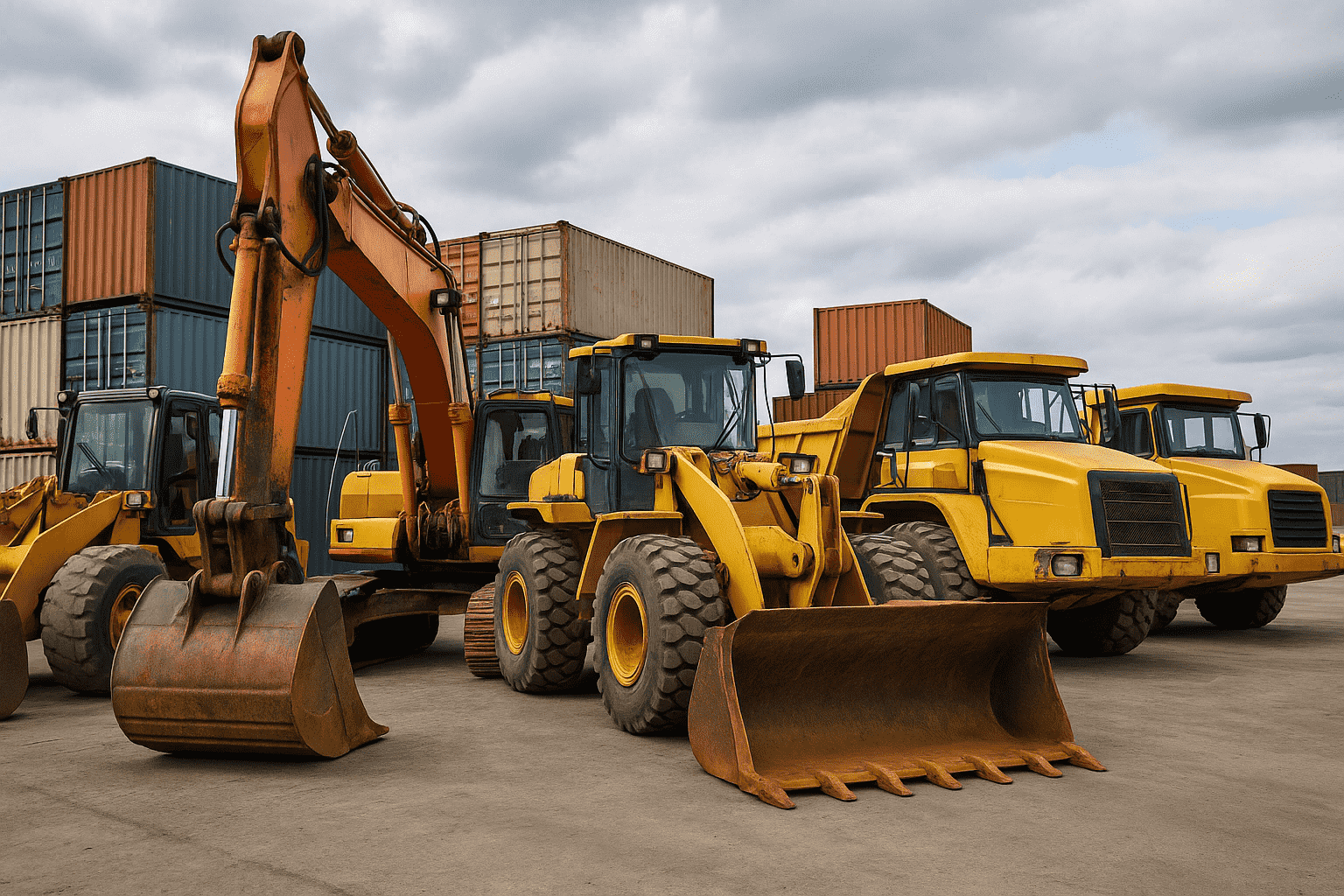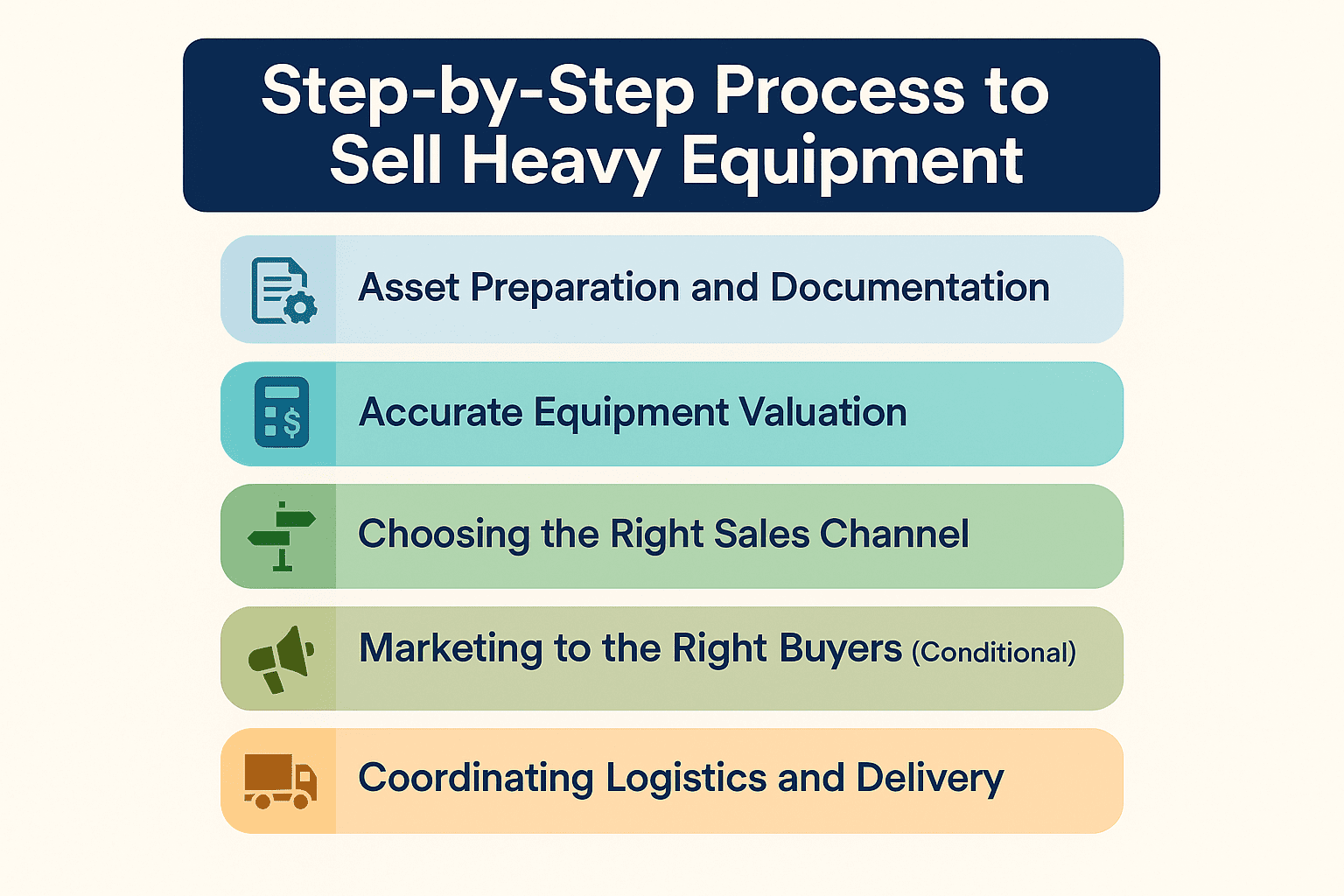How to Sell Heavy Equipment: Steps and Key Tips For Maximum Value Recovery

Idle or surplus heavy equipment drains capital and racks up unnecessary storage costs for your business. Every day that an excavator, drilling machine, loader, or crane sits unused, you lose out on significant value, especially when demand for quality used machinery remains strong in the secondary market.
A strategic approach to selling heavy equipment is crucial for maximizing value recovery. Without a plan, you risk underpricing assets, missing out on serious buyers, or encountering costly delays and compliance issues. By understanding the full resale process and adopting proven best practices, you can unlock the hidden worth in your fleet and convert unused heavy equipment into working capital.
In this guide, you’ll find a step-by-step process for selling heavy equipment. You’ll also discover actionable tips to help you achieve optimal returns, no matter the scale or type of heavy equipment you need to sell.
Understanding the Heavy Equipment Resale Market

To achieve the best returns when selling heavy equipment, it’s essential to understand the secondary market’s structure and the factors that drive value. A clear understanding of who is buying and what drives their decisions will help you position your equipment effectively and maximize your asset value recovery.
Typical Buyer Profiles:
The resale market includes a range of buyers:
- End-users: Contractors or operators who need reliable machinery for ongoing projects.
- Dealers: Businesses that purchase equipment to refurbish and resell through their networks.
- International buyers: Buyers from overseas markets seeking cost-effective equipment not readily available locally.
- Brokers: Intermediaries who connect sellers with qualified buyers and help facilitate transactions.
Key Market Drivers:
Several factors determine the marketability and value of heavy equipment, including:
- Equipment Age: Newer models generally attract more interest and command higher prices.
- Brand Reputation: Well-known brands with a track record for durability and serviceability hold their value better.
- Usage Hours: Lower operating hours signal less wear and a higher remaining lifespan.
- Maintenance History: Comprehensive service and repair records build buyer confidence.
- Demand Cycles: Seasonal or industry-specific demand fluctuations—such as construction booms—influence buyer urgency and pricing.
Step-by-Step Process to Sell Heavy Equipment

Selling heavy equipment for maximum value requires more than just listing it for sale. Following a structured, step-by-step process ensures your assets are market-ready, properly valued, and positioned to attract serious buyers. Here’s how to get started:
1. Asset Preparation and Documentation
Begin by cleaning, inspecting, and making any necessary repairs to your equipment to present it in the best possible condition. Well-maintained assets not only look more appealing but also command higher offers from buyers.
Next, compile all available maintenance logs, service records, and original operator manuals. Detailed documentation provides evidence of regular care and responsible usage, and plays a key role in building trust with prospective buyers.
Finally, gather ownership documents, equipment titles, and any required compliance certificates in advance. Having this paperwork organized and accessible helps facilitate a smooth transaction and assures buyers of a legitimate, hassle-free purchase.
2. Accurate Equipment Valuation
Determining the right value for your heavy equipment through a professional appraisal and valuation is a critical step in achieving a successful sale. Use a combination of methods to establish a fair and competitive asking price.
An accurate, market-aligned valuation positions your equipment for a faster, smoother sale and is essential for attracting serious buyers.
Overpricing can lead to stagnant listings while undervaluing assets leaves money on the table.
3. Choosing the Right Sales Channel
Selecting the most effective sales channel is key to maximizing value and expediting your equipment sale.
Consider your priorities—such as how quickly you need to sell, the level of control you require over the process, transaction costs, and your target buyer audience.
Options include direct sale to end-users, public or private auctions, listing on specialized online marketplaces, working with industrial brokers, partnering with professional liquidators, or using b2b consignment services.
4. Marketing to the Right Buyers (Conditional)
If you plan to sell heavy equipment directly, targeted marketing is essential for reaching qualified buyers and driving competitive offers.
Identify and pursue opportunities in local, national, and international markets, depending on demand and the type of equipment you’re selling.
Proactively positioning your assets when buyer activity is highest can result in faster transactions and stronger sale prices.
5. Coordinating Logistics and Delivery
Coordinating logistics and delivery is a critical step that can significantly impact the success of your sale. Properly preparing equipment for safe transport—including disassembly, secure packaging, and loading—helps protect assets from damage and ensures buyer satisfaction.
If your team lacks experience in handling heavy equipment logistics, it’s wise to partner with specialized heavy-haul logistics providers. These experts manage complex transportation requirements, obtain necessary permits, and oversee safe, efficient delivery to the buyer’s site.
Additionally, ensure all shipping documentation is complete and accurate, and secure appropriate insurance coverage for the shipment.
Key Tips to Maximize Value Recovery From Your Heavy Equipment Sales

Maximizing your return from heavy equipment sales requires more than just following the basic steps. A few targeted actions can make the difference between an average offer and top market value. Focus on these best practices to enhance your results and build buyer confidence.
Tip #1: Schedule Preventive Maintenance and Repairs Before Listing
Well-maintained equipment sells faster and commands higher prices. Completing preventive maintenance and addressing even minor repairs before listing minimizes buyer objections, shortens negotiation cycles, and puts you in a stronger position when discussing value. Service records and proof of recent upkeep give buyers the assurance they need to pay top dollar and close the deal quickly. If you want maximum recovery, invest in maintenance first.
Tip #2: Bundle Attachments or Complementary Tools to Increase Appeal
Bundling attachments or essential MRO tools with your equipment gives buyers immediate operational value and reduces their setup time. Complete packages command stronger offers and move faster, as buyers see a clear cost advantage. If you want to differentiate your listing and maximize returns, sell the machine as a turnkey solution.
Tip #3: Attach the Equipment Condition and Appraisal Report to Build Buyer Trust
Providing a detailed condition and appraisal report upfront removes the guesswork for buyers and positions you as a credible seller. Transparent documentation proves you understand your equipment’s true value and aren’t hiding issues. This confidence speeds up due diligence, attracts serious buyers, and helps you secure the best possible price.
Tip #4: Engage a Heavy Equipment Liquidation Expert with Buyer Networks
Partnering with a specialized liquidation expert who has direct access to industrial buyers gives you a clear edge in value recovery. These professionals bring qualified buyers to the table, handle negotiations, and accelerate the entire process, often achieving higher sale prices than internal teams can manage. It also frees your procurement team to focus on their core responsibilities instead of navigating complex asset sales. If maximum recovery and speed matter, put your equipment in the hands of an expert.
Tip #5: Use Logistics Partners Skilled in Heavy Equipment Shipping
Shipping heavy equipment requires more than just basic freight services. Working with logistics partners who specialize in this field protects your assets from costly damage and minimizes delivery delays. Experienced handlers know how to load, secure, and transport machinery efficiently, reducing risk, speeding up the sale, and assuring buyers that their purchase will arrive as promised. If you want to amplify value recovery and avoid expensive setbacks, invest in proven heavy-haul expertise.
How Amplio Supports Heavy Equipment Sales

As an online platform built for industrial sellers and buyers, Amplio makes it easier to recover maximum value from your heavy equipment assets, efficiently and securely. The bigger the challenge, the more value we add – we’re designed to make complex enterprise surplus disposition efficient and rewarding.
- Centralized Asset Listing and Documentation:
Amplio handles the complexity for you. We list your equipment, upload documentation, and manage everything from a single, user-friendly dashboard that gives you full visibility into what’s going on.
- Network of Pre-Vetted Buyers and Resellers:
We’ll connect your inventory instantly with a broad network of qualified buyers and resellers, speeding up sales and driving higher offers.
- Real-Time Pricing Analytics and Market Insight:
We use live secondary market data and automated pricing recommendations to ensure your equipment is positioned for the strongest returns.
- End-to-End Online Support:
Amplio's team will work with you as your disposition team in your entire transaction, from asset listing, buyer negotiations, compliance, and logistics
Contact Amplio today for online expert support that maximizes your heavy equipment value recovery and streamlines every step of the sales process.